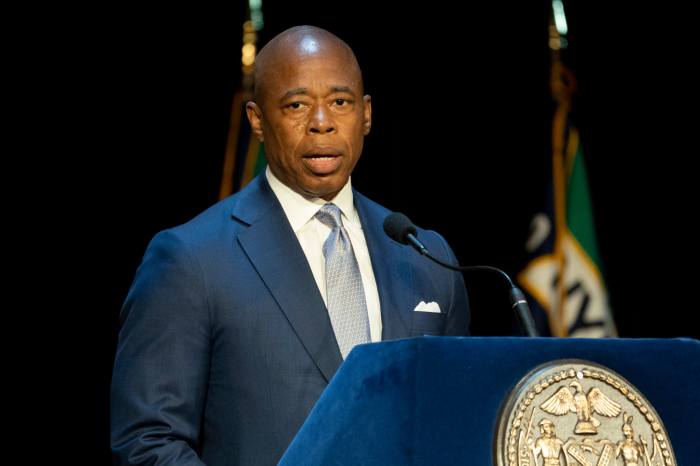NAIROBI, Kenya – As U.S. navy ships looked on, Somalian pirates sped away Thursday with US$3.2 million in ransom after releasing an arms-laden Ukrainian freighter, ending a four-month standoff that focused world attention on piracy off Somalia’s lawless coast.
The navy said it couldn’t seize the bandits for fear of endangering 147 other seamen still held hostage on other hijacked ships.
So, within sight of two nearby U.S. warships, the pirates counted the cash – air-dropped by parachute – then took off in motorboats, pirate Aden Abdi Omar said, speaking to The Associated Press by satellite phone after arriving in the central Somali town of Harardhere.
“We are not holding it (the ship) anymore,” said Omar, adding that more than two dozen pirates made their escape aboard motorized skiffs, navigating the choppy waters in small groups.
The $3.2 million booty – among the largest-ever reported ransoms – would be divvied up among the pirates, he said.
The seizure of the MV Faina, loaded with Soviet-era tanks and other heavy weapons, was one of the most brazen in a surge of pirate attacks on shipping off Somalia’s coast. Vessels from the U.S. navy’s 5th Fleet quickly surrounded the cargo ship after it was seized Sept. 25, to make sure the arms on board did not get into the hands of Somali insurgents believed to have links to al-Qaida.
The hijacking brought an unprecedented naval response. Warships from countries including the United States, India, Britain, France, Germany, China, Saudi Arabia and South Korea have joined the anti-piracy campaign, though attacks continue. Turkey’s government announced plans Thursday to send naval ships for the campaign.
On Thursday, U.S. seamen inspected the pirates’ boats to ensure they weren’t carrying any of the freighter’s weapons cargo.
But the navy did not take action against the pirates because they still hold many hostages from other ships, said Cmdr. Jane Campbell, a spokeswoman for the U.S. navy’s Bahrain-based 5th Fleet.
“Even when you release Faina, there are still 147 mariners held hostage,” Campbell told the AP. “We’re concerned for their well-being.”
Ships from the U.S. navy’s 5th Fleet closely monitored the Faina and its 20 surviving crew throughout the standoff after the captain died of a heart attack, and the United States sent medical workers to the ship Thursday once the pirates left.
“We are extremely pleased” at the release, said Vice Admiral Bill Gortney of U.S. Naval Forces Central Command. “The United States Navy and our coalition partners will continue to fight piracy, and work with the international community to find a long-term, shore-based solution to this maritime crime.”
Late Thursday, MV Faina’s acting captain Viktor Nikolsky said his ship was under the protection of the navy and would head to Mombasa, Kenya.
Negotiations for the release of the ship and its crew dragged on for months because of the interference of unidentified “third parties,” according to a statement by the ship owner, Vadim Alperin, posted on his spokesman’s website. No explanation was given.
Piracy is big business off the coast of war-ravaged Somalia, which has not had a functioning government for 18 years. Pirates made off with up to $80 million in ransom in the past year, seizing 42 vessels off the country’s 3,000-kilometre coastline along the Horn of Africa.
But no hijacking attracted as much attention as the Faina and its weapons cargo, which was a wake-up call about the danger piracy poses to one of the world’s most important trade routes.
“It showed Somali piracy no longer affected just small coastal vessels but important and dangerous cargos,” said London-based analyst Roger Middleton.
In November, pirates hijacked the Sirius Star, a Saudi supertanker filled with crude oil that was released in January. And last week they took the MV Longchamp, a German tanker filled with explosive gas.
Intelligence agents had feared the weapons onboard the Ukrainian ship – which include 33 Soviet-designed tanks and crates of small arms – could fall into the hands of Somalian insurgents the State Department says have links to al-Qaida.
Diplomats in the region previously have said the cargo was destined for southern Sudan, something the autonomous region has denied. Kenyan government spokesman Alfred Mutua repeated his country’s claim to the cargo Thursday.
The high ransom payments mean pirates are unlikely to stop attacking.
Still, Middleton said the international anti-piracy campaign has reduced the success rate of attacks to about 20 per cent. Last year, pirates took 42 of the 111 ships they attacked.
Graeme Gibbon Brooks, managing director of the British company Dryad Maritime Intelligence Service Ltd., said the drop was due to the coalition activity and unseasonably bad weather.
Most of the 16 attempted hijackings in 2009 occurred in the first two weeks of January, when the weather was good. Three of those ships were captured.
But pirates are showing a worrying new sophistication in their attacks, several experts told the AP, including greater use of global positioning systems that allow them to extend their range. Identification systems designed to stop ships from colliding can also lead pirates to potential prey because of the radio signals they put out.
The pirates may be trying to buy magnetic mines and heat-seeking missiles that can be fired from the sea, according to a recent report in Jane’s Intelligence Review. Brooks said pirates also were jamming emergency frequencies with Arabic music or sending out false distress calls to lure warships in the wrong direction.
He warned that pirates have begun to mount diversionary assaults or attacks on several vessels at the same time. “We’ve gone from a pattern of sporadic attacks to a situation where the pirates co-ordinate,” he said.
In one incident last week, pirates simultaneously attacked three ships. Coalition forces were able to save two, but the third – the Longchamp – was captured.
Vice Admiral Gerard Valin, the commander of a French naval task force, said five pirate gangs operate from Somalia, each with about 200 to 500 members.
The coalition does not issue exact figures for security reasons, but Middleton said there are between 20 and 30 warships off the Somali coast. Even with all the extra firepower, it was hard to prevent attacks, due to the vast waters and the pirates’ increasing ingenuity, Valin said.
“I will not say congratulations,” he said. “We have to respect the adversary.”
















